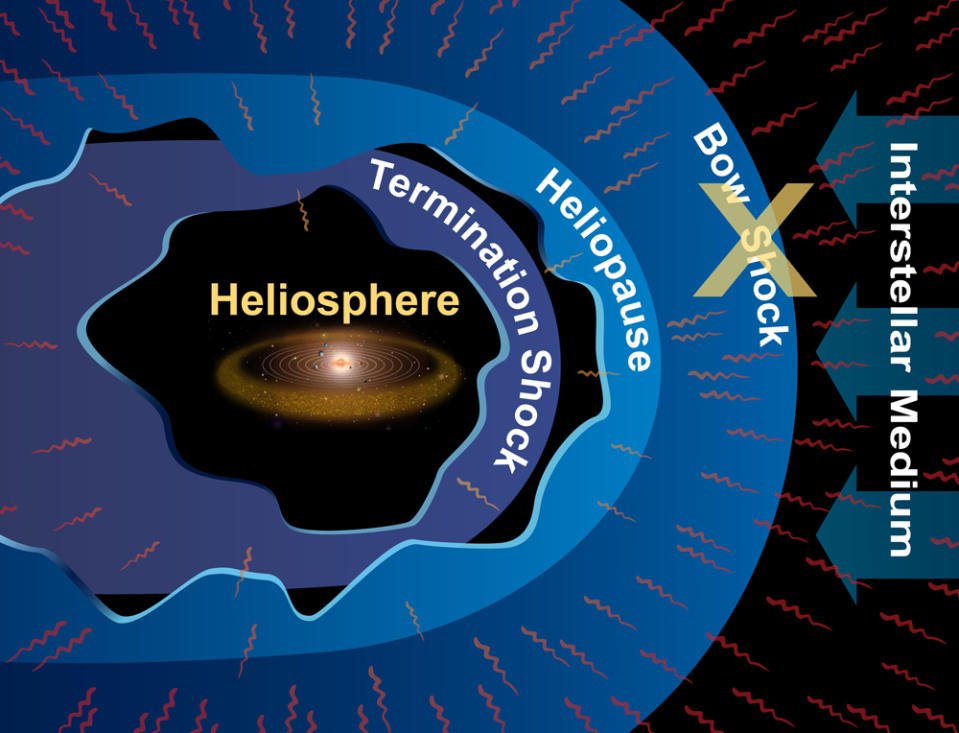Scientists believe that Earth may have briefly lost protection from the sun around two million years ago, leaving the vast environment of interstellar space to survive as the solar system passed through a dense cloud of gas and dust between the stars.
At that time, early human ancestors shared our planet with prehistoric animals such as mastodons and sabretooth tigers. It is also when the Earth was in the middle of the ice age that ended only about 12,000 years ago. Ice ages are caused by a range of factors, including the tilt and rotation of our planet, levels of carbon dioxide in the atmosphere, and shifting plate tectonics and volcanic eruptions on its surface. However, given how long scientists think Earth has passed through interstellar space, this research suggests that radical changes in our planet’s climate, such as the onset and end of ice ages, could have an impact also the location of our solar system in our home galaxy.
Specifically, the team behind the new findings suggest that the solar system may have encountered a dense patch of interstellar gas and dust as it crossed the Milky Way two million years ago. And that patch may have been thick enough to disrupt a stream of charged particles known as the “solar wind” flowing from the sun and impacting Earth, potentially causing dipping temperatures.
Related: ‘Hand of God’ interstellar cloud reaches stars in new Dark Energy Camera image (video)
“This paper is the first to show quantitatively that there was contact between the sun and something outside the solar system that would affect Earth’s climate,” said study author Merav Opher, a space physicist and expert on the helisphere at Boston University. in a statement.
The solar system, back in time
Our entire solar system is enveloped in a “giant bubble” of protective plasma that comes from the sun, called the “heliosphere.” This protective shield is created when solar winds push on the interstellar medium, which refers to matter that flows through the spaces between stars in the Milky Way. The helisphere is perpetually renewed by a steady flow of charged particles from the sun, which stream out past Pluto.
The heliosphere protects the Earth’s surface from radiation and galactic rays that can affect the DNA of living things. This shield is so vital that many scientists believe it was central to the emergence and evolution of life on Earth.
This team thinks that a cold cloud of interstellar material may have once blocked the solar wind so that the heliosphere was compressed. This could, for a brief period (in cosmic terms), deprive Earth and other planets of the solar system of the protection offered by the heliosphere.
“Stars move, and now this paper shows not only that they move, but that they undergo significant changes,” Opher said.

To find out what effect dense interstellar dust bombardment would have on Earth’s heliosphere, Opher turned back the clock with sophisticated computer models. This allowed her and the team to look at where the sun was located two million years ago and also find out where the heliosphere and the rest of the solar system were at this time.
They also tracked the progress of a string of cold, dense gas known as the “Local Ribbon of Cold Clouds” system back in time as it swept through the Milky Way. This indicated that a single dense cloud at the end of the Local Ribbon of Cold Cloud system, known as the “Local Lynx of Cold Cloud,” may oppose the helisphere.
This would expose Earth to the interstellar medium, including its heavy and radioactive elements, which are the remnants of massive stars that die in supernova explosions. The heliosphere normally blocks these particles – without that shield, these radioactive elements could rain down on Earth. This could explain an increase in isotopes of iron 60 and plutonium 244 found in Antarctic snow and ice cores and on the moon corresponding to a period of two million years ago. The time the heliosphere meets the Local Lynx of Cold Cloud also corresponds to a cooling period on Earth two million years ago.
Opher theorizes that the pressure from the Lynx Local Cold Cloud could restrict the heliosphere for as short as a few hundred years, or as long as a million years. This would all depend on how big the cloud actually was, Opher said. She also said that the heliosphere would have expanded to surround the planets again after the influence of this dense cloud subsided.
Related Stories:
— Pulsar surprises astronomers with record breaking gamma rays
— 3.3 billion Milky Way objects revealed by a massive astronomical survey
— Dark Energy Camera peels back layers of a ‘galactic onion’ stretched across space
So far, however, it is difficult to determine exactly how this cold interstellar cloud would affect Earth, including if it could start an ice age. The team will now investigate further back in time to find other times when the solar system crossed paths with dense interstellar clouds and to see if these are consistent with ice ages.
She and her team are investigating the effect of so much hydrogen and radioactive material crossing paths with the Earth’s atmosphere.
“This cloud was indeed in our past, and if we crossed something massive, we were exposed to the interstellar medium,” said Opher. “This is just the beginning.”
The team’s research was published on Monday (June 10) in Nature Astronomy.